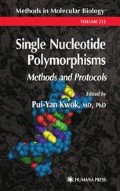Abstract
Single-nucleotide substitutions represent the largest source of diversity in the human genome. Some of these variations have been directly linked to human disease, though the vast majority are neutral. Even neutral variations are important because they provide guideposts in the preparation of detailed maps of the human genome, serving as essential elements in linkage analyses that identify genes responsible for complex disorders (1). Although sequencing is adequate for the initial discovery of single-nucleotide variations, simpler, faster, and more automated genotyping methods are needed for routine clinical diagnostics and population studies. High-throughput methods are essential for understanding the distribution of genetic variations in populations, as well as for identifying the genes responsible for genetic disorders. Current alternatives to sequence analysis either miss some single-nucleotide substitutions or are too complex to enable high-throughput assays (2).
Access this chapter
Tax calculation will be finalised at checkout
Purchases are for personal use only
References
Sachidanandam, R., Weissman, D., Schmidt, S. C., Kakol, J. M., Stein, L. D., Marth, G., et al. (2001) A map of human genome sequence variation containing 1.42 million single nucleotide polymorphisms. Nature 409, 928–933.
Cotton, R. (ed.) (1997) Mutation Detection. Oxford University Press, Oxford, UK.
Tyagi, S. and Kramer, F. R. (1996) Molecular beacons: probes that fluoresce upon hybridization. Nat. Biotechnol. 14, 303–308.
Tyagi, S., Bratu, D. P., and Kramer, F. R. (1998) Multicolor molecular beacons for allele discrimination. Nat. Biotechnol. 16, 49–53.
Tyagi, S., Marras, S. A., and Kramer, F. R. (2000) Wavelength-shifting molecular beacons. Nat. Biotechnol. 18, 1191–1196.
Vet, J. A., Majithia, A. R., Marras, S. A., Tyagi, S., Dube, S., Poiesz, B. J., and Kramer, F. R. (1999) Multiplex detection of four pathogenic retroviruses using molecular beacons. Proc. Natl. Acad. Sci. USA 96, 6394–6399.
Marras, S. A., Kramer, F. R., and Tyagi, S. (1999) Multiplex detection of single-nucleotide variations using molecular beacons. Genet. Anal. 14, 151–156.
Leone, G., van Schijndel, H., van Gemen, B., Kramer, F. R., and Schoen, C. D. (1998) Molecular beacon probes combined with amplification by NASBA enable homogeneous, real-time detection of RNA. Nucleic Acids Res. 26, 2150–2155.
de Baar, M. P., Timmermans, E. C., Bakker, M., de Rooij, E., van Gemen, B., and Goudsmit, J. (2001) One-tube real-time isothermal amplification assay to identify and distinguish human immunodeficiency virus type 1 subtypes A, B, and C and circulating recombinant forms AE and AG. J. Clin. Microbiol. 39, 1895–1902.
Steemers, F. J., Ferguson, J. A., and Walt, D. R. (2000) Screening unlabeled DNA targets with randomly ordered fiber-optic gene arrays. Nat. Biotechnol. 18, 91–94.
Matsuo, T. (1998) In situ visualization of messenger RNA for basic fibroblast growth factor in living cells. Biochim. Biophys. Acta. 1379, 178–184.
Sokol, D. L., Zhang, X., Lu, P., and Gewirtz, A. M. (1998) Real time detection of DNA.RNA hybridization in living cells. Proc. Natl. Acad. Sci. USA 95, 11,538–11,543.
Bonnet, G., Tyagi, S., Libchaber, A., and Kramer, F. R. (1999) Ther-modynamic basis of the enhanced specificity of structured DNA probes. Proc. Natl. Acad. Sci. USA 96, 6171–6176.
Hu X., Belachew B., Chen L., Huang H., and Zhang J. (2000) Fluoresence-based single-tube assays to rapidly detect human gene mutations. Stratagies 13, 71–73.
Fung, C., Tyagi, S., Harris, L., Weisberg, S., Pinter, A., and Kramer, F. R. (2002) Genetic screening using molecular beacons. Clin. Chem. 47, in preparation.
Giesendorf, B. A., Vet, J. A., Tyagi, S., Mensink, E. J., Trijbels, F. J., and Blom, H. J. (1998) Molecular beacons: a new approach for semiautomated mutation analysis. Clin. Chem. 44, 482–486.
Kostrikis, L. G., Huang, Y., Moore, J. P., Wolinsky, S. M., Zhang, L., Guo, Y., et al. (1998) A chemokine receptor CCR2 allele delays HIV-1 disease progression and is associated with a CCR5 promoter mutation. Nat. Med. 4, 350–353.
Gonzalez, E., Bamshad, M., Sato, N., Mummidi, S., Dhanda, R., Catano, G., et al. (1999) Race-specific HIV-1 disease-modifying effects associated with CCR5 haplotypes. Proc. Natl. Acad. Sci. USA 96, 12,004–12,009.
Durand, R., Eslahpazire, J., Jafari, S., Delabre, J. F., Marmorat-Khuong, A., di Piazza, J. P., and Le Bras, J. (2000) Use of molecular beacons to detect an antifolate resistance-associated mutation in Plas-modium falciparum. Antimicrob. Agents Chemother. 44, 3461–3464.
Piatek, A. S., Tyagi, S., Pol, A. C., Telenti, A., Miller, L. P., Kramer, F. R., and Alland, D. (1998) Molecular beacon sequence analysis for detecting drug resistance in Mycobacterium tuberculosis. Nat. Biotechnol. 16, 359–363.
Vogelstein, B. and Kinzler, K. W. (1999) Digital PCR. Proc. Natl. Acad. Sci. USA 96, 9236–9241.
Täpp, I., Malmberg, L., Rennel, E., Wik, M., and Syvänen, A. C. (2000) Homogeneous scoring of single-nucleotide polymorphisms: comparison of the ′’-nuclease TaqMan assay and molecular beacon probes. Biotechniques 28, 732–738.
Szuhai, K., Ouweland, J., Dirks, R., Lemaitre, M., Truffert, J., Janssen, G., et al. (2001) Simultaneous A8344G heteroplasmy and mitochondrial DNA copy number quantification in myoclonus epilepsy and ragged-red fibers (MERRF) syndrome by a multiplex molecular beacon based real-time fluorescence PCR. Nucleic Acids Res. 29, E13.
Mullah, B. and Livak, K. (1999) Efficient automated synthesis of molecular beacons. Nucleosides Nucleotides 18, 1311–1312.
Author information
Authors and Affiliations
Editor information
Editors and Affiliations
Rights and permissions
Copyright information
© 2003 Humana Press Inc.
About this protocol
Cite this protocol
Marras, S.A.E., Russell Kramer, F., Tyagi, S. (2003). Genotyping SNPs With Molecular Beacons. In: Kwok, PY. (eds) Single Nucleotide Polymorphisms. Methods in Molecular Biology™, vol 212. Springer, Totowa, NJ. https://doi.org/10.1385/1-59259-327-5:111
Download citation
DOI: https://doi.org/10.1385/1-59259-327-5:111
Publisher Name: Springer, Totowa, NJ
Print ISBN: 978-0-89603-968-1
Online ISBN: 978-1-59259-327-9
eBook Packages: Springer Protocols

